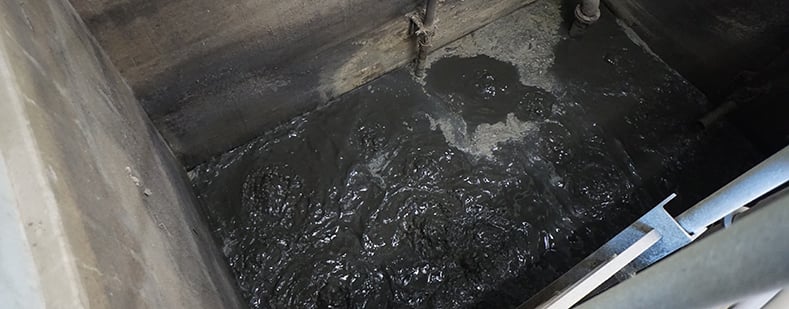When conducting surface preparation work in wastewater treatment plants, there are many factors to consider before blasting ever begins. For example: protecting the pipes, sensitive equipment, and electrical conduit from abrasive dust and ricochet. Not to mention ensuring that the ventilation system is not overwhelmed with abrasive dust.
In the case of three below grade concrete sludge tanks at the Kennebunk Sewer District, minimizing media waste and clean up was also paramount to job success according to contractor Marston Industrial Services who used Sponge-Jet Sponge Media to prepare the district’s tanks for application of a new protective coating system.
Abrasive blasting with Sponge Media was the right choice for the Kennebunk Sewer District job for a variety of reasons, but dust control was at the top of the list. “There were three concrete sludge tanks we needed to work on, one at a time. All three tanks are in the same area, and the tanks we weren’t working on were to be kept in service with the ventilation system on the entire time. We couldn’t afford to create a lot of dust while abrasive blasting,” said Jim Marston, president of Marston Industrial Services.

Ordinary abrasive blasting would have created a great deal of dust, forcing the Marston crew to reroute the air supply in order to protect the process equipment and control room. “Because Sponge Media blasting creates little to no dust, all we had to do was put up a poly curtain between the tanks. No other containment was necessary,” explained Marston. In fact, the Kennebunk Sewer District operators were able to get in and out of the area to monitor the working concrete sludge tanks throughout the entire duration of the job without impacting either the functionality of the tanks or the sponge abrasive blasting process.
In addition, Sponge Media abrasive created very little ricochet during the blast process. “With traditional abrasive blasting, we would have had to wrap all the surrounding piping in rubber to protect them from the ricochet. Instead, we just had to cover the piping with reinforced poly. This was a much easier and less labor intensive process,” said Marston.
Big Tanks, Easy Cleanup
Another advantage to using Sponge Media instead of conventional abrasive media was recyclability. The Marston crew originally looked into using JetMag media, but quickly realized that the single use abrasive would create a cleanup nightmare. “If we’d gone with our original plan to blast with ordinary abrasives we would have used 8,000 lbs (3,629kgs) for each of the 2,000ft² (185m²) concrete tanks. Compare that with only seventeen 30lb (13.6kg) bags of Silver 60 Sponge Media per tank,” revealed Marston. The crew would have needed to bring in vacuum trucks, and the disposal process would have been time-consuming and expensive, especially considering the tanks are 15-feet below grade. “With the recyclability of the Sponge Media, cleanup was easy and not labor intensive at all,” said Marston.
Creating The Right Profile
Creating the proper profile on the concrete was a top priority for this job. Once the Marston crew (which consisted of 2-3 men), manually peeled off the failing rubberized coating system, they were ready for the Sponge-Jet abrasive blasting process. “The Silver 60 Sponge Media created the specified profile of ICRI CSP 3 without damaging the concrete,” said Marston. This meant that no concrete filling or repair was needed prior to the application of the new coating system.
According to Marston, using a traditional abrasive blasting media would have been more labor intensive and ultimately more costly. “Time is money, so all of the time we saved on the set-up and cleanup of the abrasive blasting portion of the job saved the Kennebunk Sewer District a lot of money. And because Sponge Media abrasive blasting doesn’t damage the concrete, we didn’t have to spend any time, money or resources on concrete repair after the blast,” said Marston.
He is also quick to point out that with Sponge Media abrasive blasting creating little to no dust; the enhanced visibility on the jobsite allowed the crew to keep on schedule without having to go back and “touch up” areas that they missed on the first pass. “According to our foreman, there was at least 75% less dust on the jobsite,” said Marston. The low dust attribute, combined with all of the other advantages of blasting with Sponge Media, was a huge factor in the success of the overall coating removal, surface preparation and recoating job.








